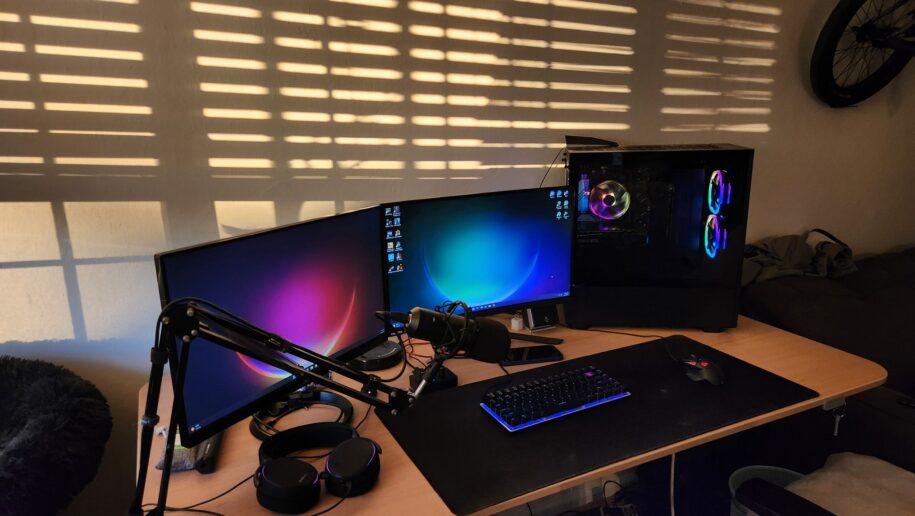
Pick the right monitor with these helpful tips. Your gaming PC may be the thing that powers all of your games, but all that hardware performance means nothing if you can’t see what you are playing. This is where monitors come in. There are so many options when it comes to monitors to pair with your CyberPower gaming desktop, and that amount of choice is overwhelming. Fret not, it’s not that hard to decide on a monitor, you just need to keep a few things in mind when picking out a monitor. Let’s break down the basics of what you need and features you should look for when picking out a gaming monitor.
Table of Contents
Pick the right Monitor – Size
First things first, size matters, but it’s not the only thing that does. A massive monitor might seem enticing, but consider the size of your desk. Sitting in front of a massive monitor, depending on your distance from it, can be quite an uncomfortable viewing experience. The last thing you want to feel is like you’re sitting in the front row at a movie theater. Opt for a size that fits comfortably in your space and provides an immersive gaming experience without straining your neck or eyes. For most desks, 27inches or 32 inches provide the perfect amount of screen space for your games.
Pick the Right Monitor – Resolution
Pixels are the building blocks of any image on screen, so make them count! Higher resolution means more pixels, which means sharper images and more detailed graphics. But it also means that you need a graphics card with enough power to render all of those pixels. Take into account your graphics card when you decide on what resolution you want. 1080p used to be the gold standard, but now a days 1440p is the sweet spot. 4K monitors are starting to become another option as well as graphics cards become more powerful. Choose a resolution that matches your graphics card’s capabilities for optimal performance.
Pick the Right Monitor – Refresh Rate
Nobody likes a choppy game. Refresh rate, measured in Hertz (Hz) will determine how many frames a second your monitor can display. A higher refresh rate ensures smoother gameplay, as you monitor can keep up with the amount of frames being rendered by your graphics card. Shoot for a monitor with at least a 144Hz refresh rate – your eyes will thank you during those intense gaming sessions.
Also consider the type of games you play. Let’s say you love the competition of Valorant. You want a monitor that can display as many frames per second as possible to give yourself an edge. In a scenario like this, an even higher refresh rate monitor, say 240HZ, at 1080p resolution would be a great option.
Pick The Right Monitor – Response Time
In the gaming world, response time is the superhero that saves you from motion blur and ghosting. Aim for a monitor with a low response time, ideally 1ms. This ensures that your screen reacts lightning-fast to your commands, making motion look nice and smooth instead of a blurry mess.
Pick The Right Monitor Panel Technology
There’s a trio of panel technologies to choose from, each with its pros and cons. IPS (In-Plane Switching) offers vibrant colors and wide viewing angles, making it ideal for immersive gaming. TN (Twisted Nematic) panels are budget-friendly and boast low response times. TN panels are often seen with high refresh rate monitors aimed towards competitive gamers. VA (Vertical Alignment) panels strike a balance between the two, providing good color reproduction, as well as good response times. Consider your gaming priorities and budget when choosing the right panel for your gaming setup.
Pick The Right Monitor – Adaptive Sync Technologies
These features synchronize your monitor’s refresh rate with your graphics card, creating a tear-free and smoother gaming. For example if a game was running at 122 FPS on a 144Hz monitor, the monitor will adapt to this and run at 122 FPS instead. Synchronizing like this prevents screen tearing – an unpleasant visual artifact. Because the refresh rate adapts to match the GPU output, the GPU no longer has to create duplicate frames which lowers input lag and judder.
FreeSync and G-Sync are essentially brand names for specific adaptive sync tech from AMD Radeon and NVIDIA GeForce, respectively. Modern GeForce graphics cards will support either technology just fine. On the AMD side, Radeon owners can us adaptive sync if the monitor is G-Sync compatible, or if the monitor newer than about 2019. Essentially, any monitor released in the past 4 years will work well with either hardware.
Price
This should go without out saying, but we will point it out anyway. When it comes to purchasing anything for your gaming setup, take your budget into consideration. Establishing a price range will help narrow down your options. Start with a budget and then begin accounting for what features you would like your monitor to have.
Where to Purchase a Gaming Monitor
We have a limited selection of monitors on our website that can be added to your PC order, or purchased a la carte on our gear store. If you aren’t seeing one that you like, you can purchase a monitor from stores like Best Buy or Micro Center (if you are lucky enough to have one near you). Of course Amazon and any other online or brick and mortar retailer is an option as well.
There you have it. Hopefully you walk away from this article armed with knowledge you need to make an informed purchase on your next gaming monitor. You know the lingo, you know what you want and need – so go make it happen.